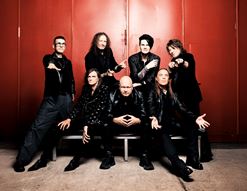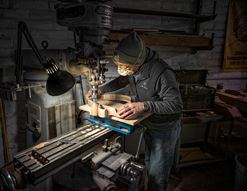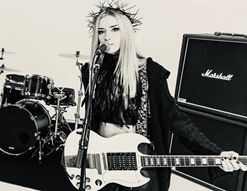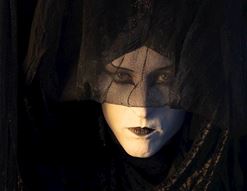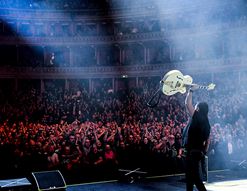Schecter have always been a brand who do things differently. Their guitar models, inlays and in particular, their graphic finishes have always been unique and head-turning. They have a taste for the surreal, the eye-catching and the more adventurous in terms of visuals, and you never quite know what you’re going to get from them next.

Today, I want to highlight a new range of particularly wild looking guitars, not only because they look awesome but because there’s a fascinating story behind them! These guitars are a collaboration between Schecter and PRZYM, a British Custom paint company who are best known (at the moment) for their custom car art!
I caught up with the PRZYM guys recently on Zoom to discuss the company, their move into the guitar world, and their collaboration with Schecter.
Here’s the full story, from the PRZYM chaps themselves…
Contents
Memorable Jobs and Narrative Art
PRZYM Origin Story
Przym is headed up today by two brothers, John & Paul Przybyl. The company goes further back though, to their father Andy and an enduring love for drag racing.

John (left) and Paul (right) Przybyl of PRZYM
“He started painting way back in 1977, focussing mostly on car body crash repairs. He drag-raced on the side, and had the nickname ‘Andy Gleam Machine’ because of his constantly shining gloss red V8 ford pop drag car he built/painted himself. People from the racing scene started asking him to paint their racecars to the same level, so he got a name for himself that way. He’d work crash repair through the week and then paint race car jobs at the weekend.
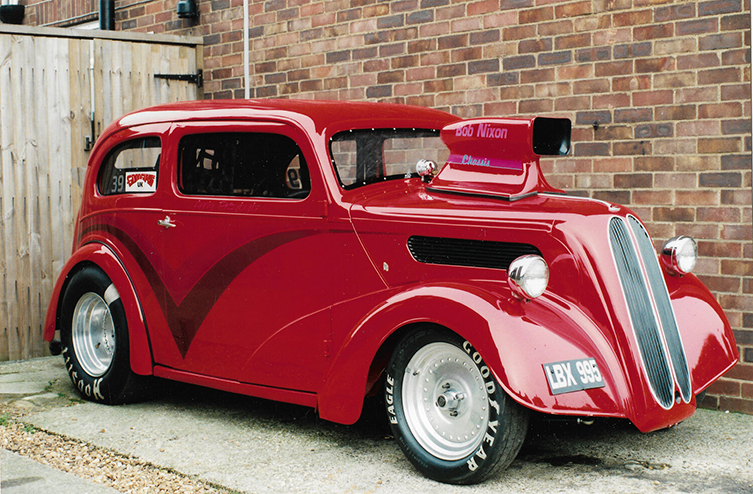
He continued to paint racecars for 25-30 years and then we were born into the scene. When we got old enough, we took an interest in his painting. Growing up, we'd spend weekends at the track and he’d always have some sort of wild car he was painting up at home in the garage. So, custom painting/racing was something we were surrounded by.
He set up PRZYM Paintworks in 2010 working for himself, and focused on a range of cars. When we got to an age to be able to do it, "racing our own PRZYM dragster ourselves and knowing our way around a spray gun" we just kind of flowed into working within the business, and it became a three-way team.”
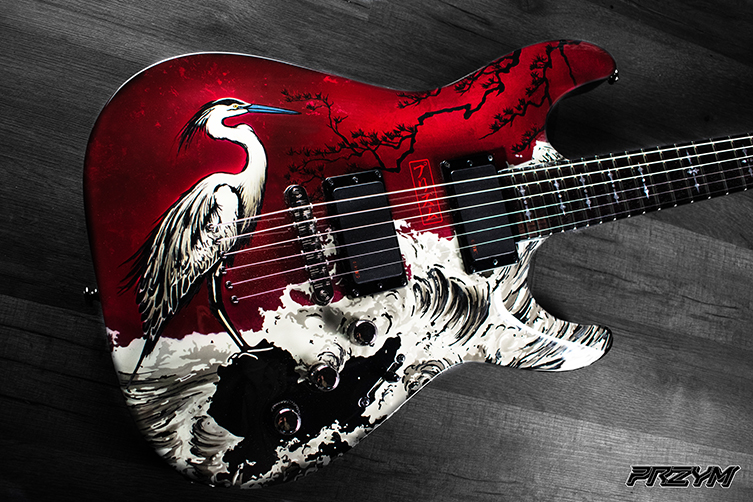
It seems that a natural love for painting and artistry runs in the family: (Paul) “When I was a little kid I was obsessed with the Ed Roth Rat Fink thing, so when we were little, the cool cars to me always had flames, chrome and skulls over them, all of the wild things. I was an artist from really early on, I used to draw all the time. They’d give me crayons to shut me up! When I was about 14, a family friend through the race scene let me loose on his son's junior dragster, to do whatever paintjob I wanted on it! I could finally go wild in my imagination and it would become a real world object on the track.”
Custom Guitar Finishes
From those beginnings came some spectacular cars and custom-sprayed helmets before people started approaching PRZYM to do guitars.
“We had a few people come in who weren’t car customers. They were guitar players wanting nice show level finishes, and from watching our dad paint these guitars, we then started doing them ourselves. I’d be around 16 at the time (John) we did a few guitars for people, and then that got the sort of gears working as to how you could apply similar paintjobs to guitars like that.”
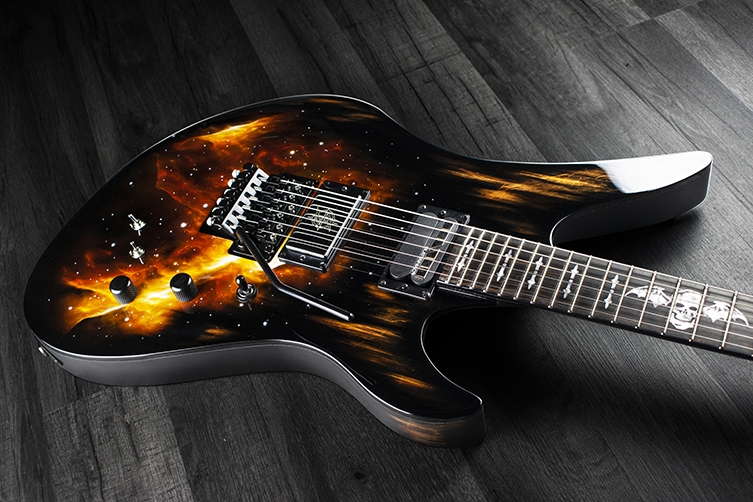
Guitars of course are smaller and made of wood. I wondered if there were any difficulties in translating the skillset across to this new canvas? Apparently not!
“To be honest, a lot of the racecars are carbon fibre bodies, and you work on them a panel at a time, so it felt natural working on a small area and focusing on one panel.
When we get a guitar, instead of painting part of a design, we just make the whole design translate over. We prep them mostly the same way we would do a racecar anyway. But it’s different being wood, since wood tends to soak in paints and stuff, so there’s a couple of extra steps you need to do, but the same techniques apply otherwise, which is a cool thing in itself”.
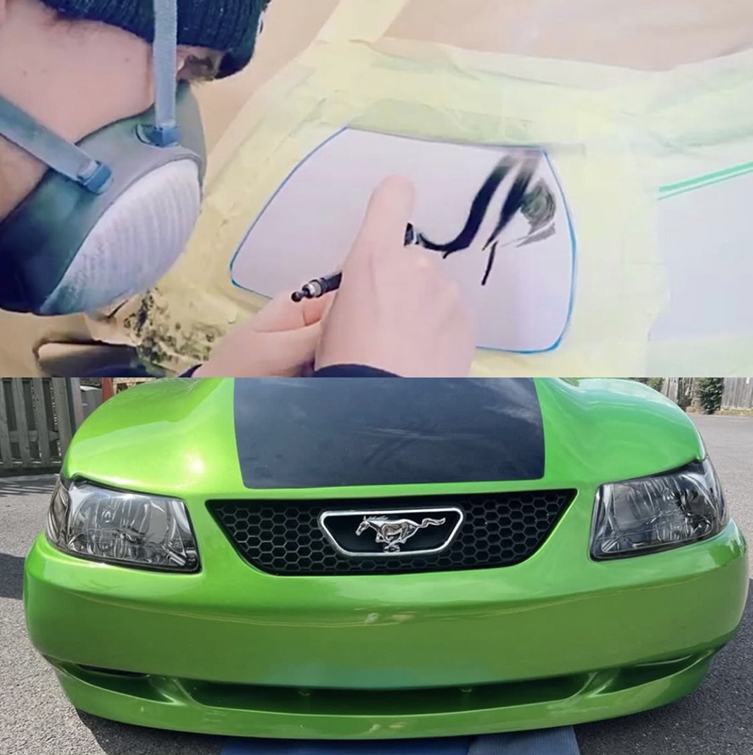
Even the materials can be the same as what’s used on the car panels: “It depends on what we’re doing, but we like working with car solvent paints because we know exactly how we need to thin it, mix it and prep it. Sometimes, say, if you used acrylic paint or house paint, it’s not gonna stick or thin properly. It’s a nightmare to work with. We use the same paints that we use on cars, I like to think that guitars are like a hotrods in some ways, they both have custom paint/chrome and with both having classic models/finishes throughout time. They’re a little piece of that same universe that go hand in hand.”

The Process
I wanted a little more detail on what the brothers actually do when they go about producing their custom art. Was it a case of masking off layers with tape and then getting busy with an airbrush?
“Some designs have been completely freehand, the whole thing. We do it a lot in layers: they look terrible for ages and then, all of a sudden, the top layers evolve into ‘oh wow’, haha! you really have to trust the process. Once you start peeling back the layers, they start flowing into each other, but yeah, normally if it’s a fine detail piece, I’ll either paint the background area first and then clearcoat that to lock it in, then we’ll mask it and do the detail work.”
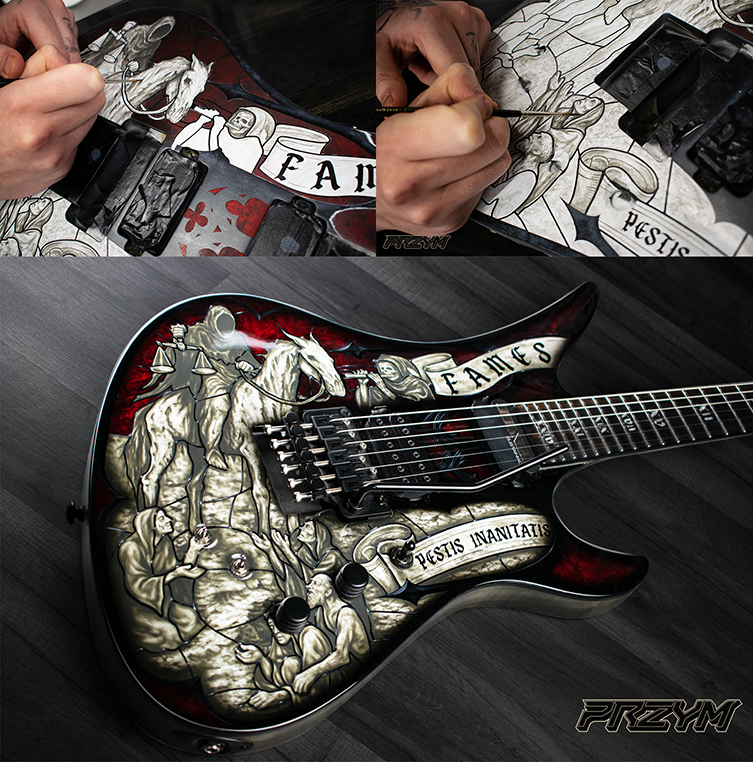
Ah, so the clearcoat isn’t the last thing you do?
“Nope, every fifth or sixth layer, we'll probably lay down a layer of clear, just to sort of save the progress. If anything messes up, we can sand it back to the clearcoat. If, say, I was doing a skeleton and the background was a forest, if I mess up the skeleton, I can sand it back and go again. We’ve saved the forest!”
It’s like saving your video game before you fight a Boss, right?
“Yeah, exactly, save the progress!”
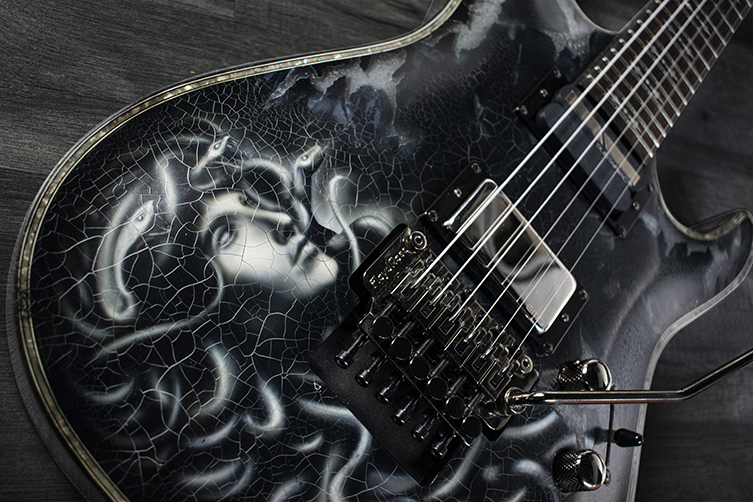
Each job is different with PRZYM, and there is no standard estimation when it comes to how long a job will take. That said, I did want to push the boys slightly for more detail on how long the process generally is.
“Some of them - the wood burn ones - I can do two/three days straight till midnight. Zone out, lock in, and just be on it until they’re done. But when you’ve got to let things dry; you can't rush any of it. You get things as far as you can and then you have to wait 4 days for that coat to fully cure, for example.”

“Also, in the past, we’ve tried to force a design to happen visually. It’s half there but it's not quite right and needs changes, so then we go back a stepping stone instead of pushing on, and the end result is always better. We start it, put it to one side for a bit, then all of a sudden we have a brainwave, a second attempt at it, and it just seems to flow so much easier.”
And as for the job times themselves…”The longest has probably been a month, but that’s for a really detailed realism portrait. The trouble is, you’re not constantly doing them, you’re working on a lot of things at once. In terms of how long from start to finish, most of them you could get out in a week, if that’s all you were doing. Right now there’s two helmets, a guitar and some other race designs we're working on, so it's a lot of juggling, it’s not just sitting down to focus on one thing all day.”

Memorable Jobs and Narrative Art
“We’ve done a few commissions for celebrities that are quite memorable. One of our early ones was a skateboard for Ryan Sheckler, dedicated to his little French Bulldog, Walter. His friend commissioned it, and the challenge was ‘how do you put a dog on a skateboard and make it look cool?’ We did our usual process of doing a background in our sort of style and using that as a frame with Walter in the middle.
Ryan sent us a picture of in his display case next to his X Games trophies and it seemed nuts to have our stuff side by side with such big things we've known all our lives!
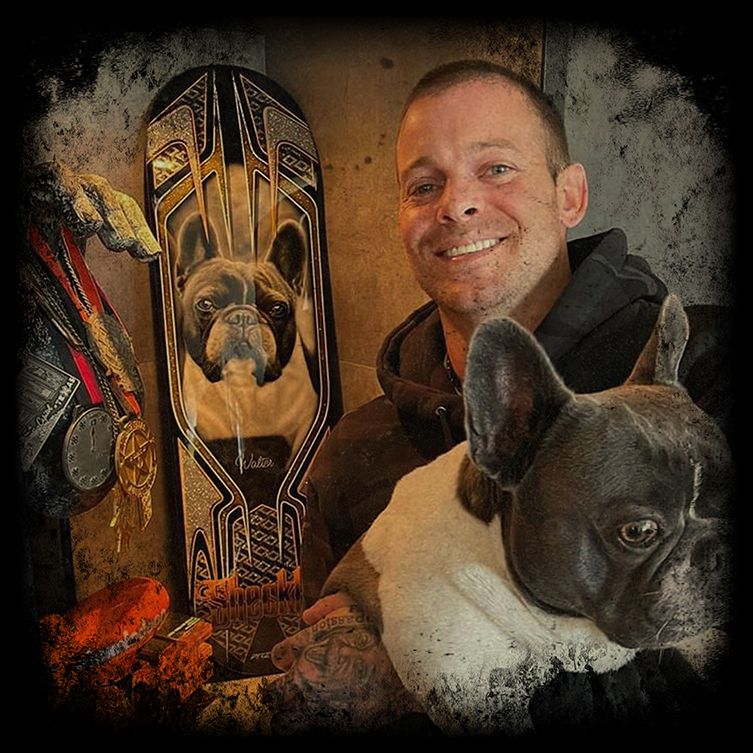
In terms of guitars, we’ve had a couple that are interesting. We recently did one for Post Malone (see further below).
A lot of the way we’ve been doing things these past two years is, we’ve just been focussed on creating what we’ve wanted to create, and putting them out there on the internet for sale. We’ve had commissions too, but a lot of them are from overseas, so it’s more difficult shipping it two-ways.
We like to think up and visualise a story for each piece. For example, we did one recently with a cyborg robot and a butterfly. That’s all hand-burned. With the theme on the current AI art influence, and if it will ever overtake the real world. That’s what we went for: remember nature, basically. That’s also why we chose a natural method with the hand burning, rather than using artificial paints.
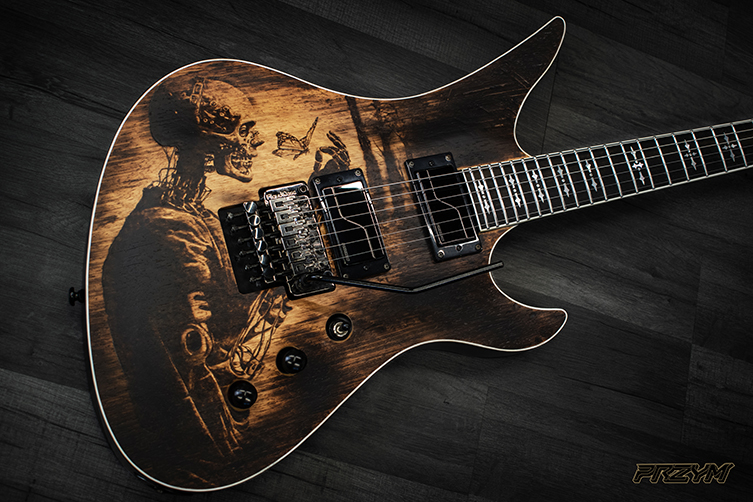
Pyrography
I went back to John’s comment about ‘hand-burning’ and asked him to expand.
“Pyrography, it’s kind of like a soldering iron used for wiring. It goes red hot on the end and we just touch it down briefly. It’s for line work and shading, and I use it like a pen: the longer you hold it, the darker it gets. The quicker you go, the lighter it gets so you just go over it and over it until you get what you want.”
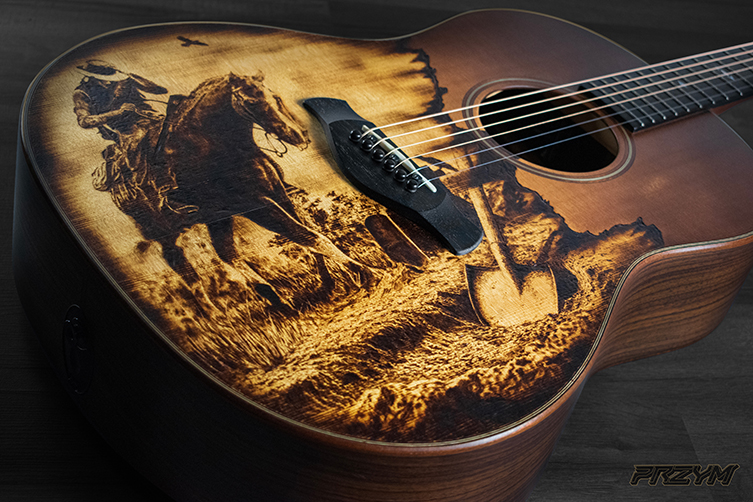
The incredible cowboy design for Post Malone, based on his lyrics.
Avenged Sevenfold
The story of PRZYM’s collaboration with Schecter begins with a love for one of their biggest endorsees, Avenged Sevenfold.
“We’ve been fans of Avenged Sevenfold for a while now. Synyster Gates got me into playing guitar. When I was 16, I went to a guitar shop and saw an all-white Schecter Synyster Special guitar and fell in love. I bought that as my first "good" guitar and have been playing since then.
In 2023, they did a surprise show before their LIBAD album release and we were invited out to see that. We’ve got a friend who is involved in their circle so we went along to that Las Vegas show and ended up in the bar afterwards with Synyster Gates. We had a conversation and showed him some of our previous work.
We hadn’t done a guitar for a while at that point so as soon as we got home, we decided to do another. One was our take on a story about whatever you create in life that’s beautiful, eventually the world is gonna end and everything’s gonna deteriorate (laughs). So we did this Roman statue and the story was like: Once upon a time, someone created that statue and put their heart and soul into it, and then, no matter what, it’s all destroyed by time. It’s like, eventually things will end anyway, so just do things you enjoy and see what happens. We did that, and added a finish where the guitar is half clean and half worn, where time has overtaken it.
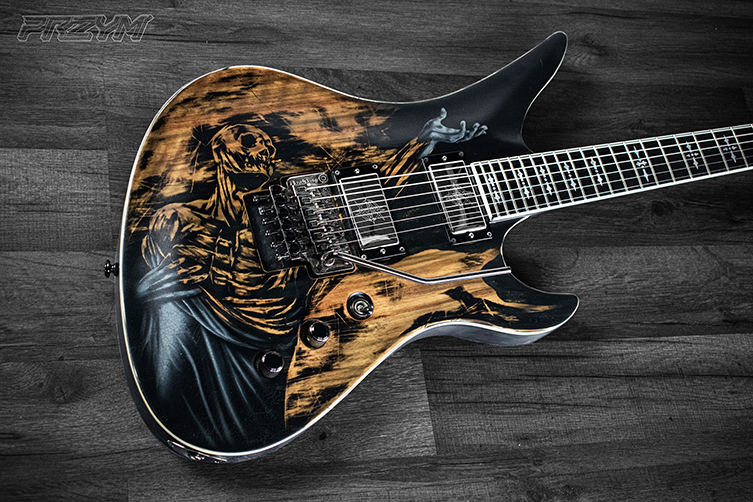
We posted that on Instagram and it just blew up. It was just John’s own personal guitar that we painted up for ourselves, just for a bit of fun! We weren’t expecting anything to come of it, but Schecter themselves liked the post. That got us thinking about how cool it would be to work with Schecter on guitars.
We kept doing more guitars and they kept liking the pictures, so eventually I reached out to Marc, the Vice-President there. He said he really loved what we were doing and would love to work on something together.”
Schecter & PRZYM
Schecter are of course a huge company with their own ideas and priorities, and I wondered about how the collaboration process actually worked out. Was there give and take?
“They were amazing, they really were. We flew over there and they literally said to us, ‘We love what you do, this is the kind of finish we’ve aiming for (showing them a Wylde Audio Barbarian guitar): you guys know what you’re doing, just do your thing and we’ll see what happens.’
They liked what we initally did and then asked us to design some matching inlays for them. They were so good at letting us have the freedom we needed. It couldn’t have been more catered to us, really. From the designs, to the inlays, to the name, we were fully on board as collaborators. We never expected that much freedom!”

I mentioned that it was really smart of Schecter to get creative people and then understand that the whole point is for those creatives to do what they are good at. Not a lot of companies do that!
“A lot of their signature artists say the same thing in interviews: they let me do what I wanted to do. We’ve seen that first-hand, and I think that works really well.”
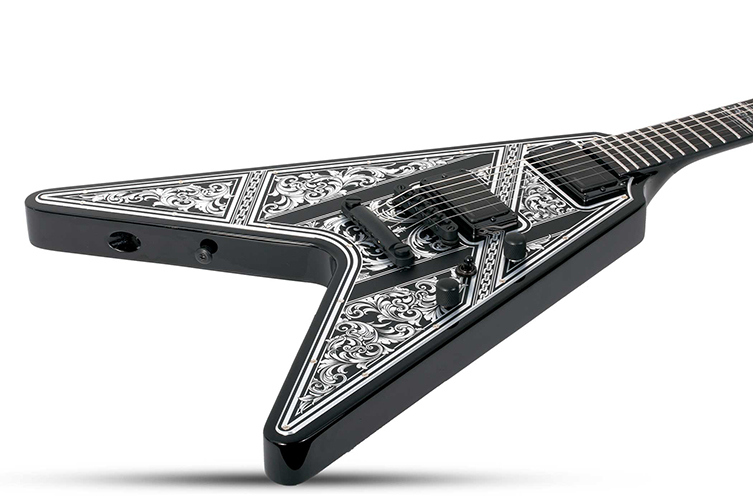
I wondered about PRZYM’s expectations: how close were the finished guitars to their ideals?
“They were fantastic, they exceeded them. Everything we designed was there, reproduced perfectly. When they first sent photos of the finished models, I actually thought it was photos of my own prototype we made sent back to me, it was so exact!”
Hopefully, this will just be the beginning of a beautiful relationship between Schecter and PRZYM. The guys work hard and the results are exceptional. This range of guitars with Schecter are very on-brand for both companies, which is probably why they work so well.
Check out the guitars by hitting the button below, and head over to the PRZYM website for more info on the guys and their work. Thanks to John and Paul, not only for their time with me, but for suppplying us with so many excellent photos!
(All pictures on this blog (apart form the Schecter stock images, which are guitarguitar images) are the property of PRZYM, and used with permission.)
Click to View our Schecter PRZYM Guitars


